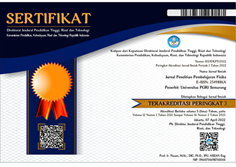Utilizing Sequential Pattern Mining and Complex Network Analysis for Enhanced Earthquake Prediction
DOI:
https://doi.org/10.26877/asset.v6i4.1003Keywords:
Complex Network Analysis, Sequential Pattern Mining, Sequential Rule Mining, Centrality Measurement, Minimum SupportAbstract
Earthquakes are natural events caused by the movement of the earth's plates, often triggered by the energy release from hot liquid magma. Predicting earthquakes is crucial for raising public awareness and preparedness in seismically active areas. This study aims to predict earthquake activity by identifying patterns in seismic events using Sequential Pattern Mining (SPM). To enhance the prediction accuracy, Sequential Rule Mining (SRM) is applied to derive rules with confidence values from these patterns. The results show that using betweenness centrality as a weight increases the prediction accuracy to 83.940%, compared to 78.625% without weights. Using eigenvector centrality as a weight yields an accuracy of 83.605%. These findings highlight the potential of using centrality measures to improve earthquake prediction systems, offering valuable insights for disaster preparedness and risk mitigation.
References
S. L. University of Moratuwa, Institute of Electrical and Electronics Engineers. University of Moratuwa Student Branch, S. Lanka. E. R. U. University of Moratuwa, Institute of Electrical and Electronics Engineers, and IEEE Sri Lanka Section, MERCon 2019, Multidisciplinary Engineering Research Conference: Book of Conference Proceedings: 5th International Multidisciplinary Engineering Research Conference: 3rd-5th July 2019, University of Moratuwa, Sri Lanka.
U. Brandes et al., ASONAM 2018: Proceedings of the 2018 IEEE/ACM International Conference on Advances in Social Networks Analysis and Mining: Barcelona, Spain, 28-31 August, 2018.
Y. Rusmawati, “Earthquake Patterns Identification Based on Network Centrality Measurements and Earthquake Type,” in Proceedings - 2022 IEEE International Conference on Big Data and Smart Computing, BigComp 2022, Institute of Electrical and Electronics Engineers Inc., 2022, pp. 76–81. doi: 10.1109/BigComp54360.2022.00025.
S. Oldham, B. Fulcher, L. Parkes, A. Arnatkeviciūtė, C. Suo, and A. Fornito, “Consistency and Differences Between Centrality Measures Across Distinct Classes of Networks,” PLoS One, vol. 14, no. 7, Jul. 2019, doi: 10.1371/journal.pone.0220061.
J. Kawash, M. Kaya, M.-Y. Day, and S. Khoury, Social Network Based Big Data Analysis and Applications, Springer International Publishing, 2018.
Wiley, Social Network Analysis: Theory and Applications, 2022.
A. Mintzelas and N. V. Sarlis, “Minima of the Fluctuations of the Order Parameter of Seismicity and Earthquake Networks Based on Similar Activity Patterns,” Physica A: Statistical Mechanics and Its Applications, vol. 527, Aug. 2019, doi: 10.1016/j.physa.2019.121293.
K. M. Asim, A. Idris, T. Iqbal, and F. Martínez-Álvarez, “Earthquake Prediction Model Using Support Vector Regressor and Hybrid Neural Networks,” PLoS One, vol. 13, no. 7, Jul. 2018, doi: 10.1371/journal.pone.0199004.
K. M. Asim, F. Martínez-Álvarez, A. Basit, and T. Iqbal, “Earthquake Magnitude Prediction in Hindukush Region Using Machine Learning Techniques,” Natural Hazards, vol. 85, no. 1, pp. 471–486, Jan. 2018, doi: 10.1007/s11069-016-2579-3.
I. M. Murwantara, P. Yugopuspito, and R. Hermawan, “Comparison of Machine Learning Performance for Earthquake Prediction in Indonesia Using 30 Years Historical Data,” Telkomnika (Telecommunication Computing Electronics and Control), vol. 18, no. 3, pp. 1331–1342, 2020, doi: 10.12928/TELKOMNIKA.v18i3.14756.
W. Gan, J. C. W. Lin, P. Fournier-Viger, H. C. Chao, and P. S. Yu, “A Survey of Parallel Sequential Pattern Mining,” ACM Trans. Knowl. Discov. Data, vol. 13, no. 3, Jun. 2019, doi: 10.1145/3314107.
[12] J. K. Tarus, Z. Niu, and D. Kalui, “A Hybrid Recommender System for E-Learning Based on Context Awareness and Sequential Pattern Mining,” Soft Comput., vol. 22, no. 8, pp. 2449–2461, Apr. 2018, doi: 10.1007/s00500-017-2720-6.
E. P. Nugroho, R. Megasari, E. Junaeti, and S. R. Pribadi, “Implementation of CM-SPADE Algorithm in Building Denial of Service Detection System Model Using Snort,” in Proceedings of the 7th Mathematics, Science, and Computer Science Education International Seminar, MSCEIS 2019, European Alliance for Innovation, 2020. doi: 10.4108/eai.12-10-2019.2296332.
M. K. Phyu and K. M. San, “Mining Sequential Pattern by Prefix-Projected Pattern Growth for Protein Sequences,” 2020.
N. Swamy, T. M. Veeragangadhara, and Vani, “A Performance Metrics Estimation of Spade, Prefix Span, Fast, and Lapin Algorithms,” in Sentimental Analysis and Deep Learning, V. E. and K. S. and D. K.-L. Shakya Subarna and Balas, Ed., Singapore: Springer Singapore, 2022, pp. 515–526.
I. M. Murwantara, P. Yugopuspito, and R. Hermawan, “Comparison of Machine Learning Performance for Earthquake Prediction in Indonesia Using 30 Years Historical Data,” Telkomnika (Telecommunication Computing Electronics and Control), vol. 18, no. 3, pp. 1331–1342, 2020, doi: 10.12928/TELKOMNIKA.v18i3.14756.
B. Aslam, A. Zafar, U. Khalil, and U. Azam, “Seismic Activity Prediction of the Northern Part of Pakistan from Novel Machine Learning Technique,” J. Seismol., vol. 25, no. 2, pp. 639–652, Apr. 2021, doi: 10.1007/s10950-021-09982-3.
Q. Wang, Y. Guo, L. Yu, and P. Li, “Earthquake Prediction Based on Spatio-Temporal Data Mining: An LSTM Network Approach,” IEEE Trans. Emerg. Top. Comput., vol. 8, no. 1, pp. 148–158, Jan. 2020, doi: 10.1109/TETC.2017.2699169.
IEEE Computational Intelligence Society, International Neural Network Society, Institute of Electrical and Electronics Engineers, and IEEE World Congress on Computational Intelligence (2020: Online), 2020 International Joint Conference on Neural Networks (IJCNN): 2020 Conference Proceedings.
B. Aslam, A. Zafar, U. A. Qureshi, and U. Khalil, “Seismic Investigation of the Northern Part of Pakistan Using the Statistical and Neural Network Algorithms,” Environ. Earth Sci., vol. 80, no. 2, Jan. 2021, doi: 10.1007/s12665-020-09348-x.
H. Q. Vu, G. Li, R. Law, and Y. Zhang, “Travel Diaries Analysis by Sequential Rule Mining,” J. Travel Res., vol. 57, no. 3, pp. 399–413, Mar. 2018, doi: 10.1177/0047287517692446.
M. H. Santoso, “Application of Association Rule Method Using Apriori Algorithm to Find Sales Patterns Case Study of Indomaret Tanjung Anom,” Brilliance: Research of Artificial Intelligence, vol. 1, no. 2, pp. 54–66, Dec. 2021, doi: 10.47709/brilliance.v1i2.1228.











